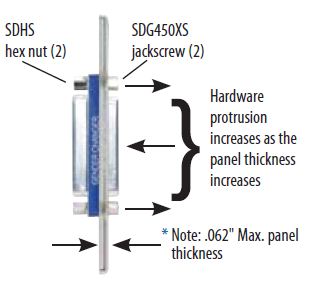How to Panel Mount D-Subminiature Connectors
(blogger@L-com.com)
As L-com mentioned in one of its newsletters, D-Subminiature connectors are still used in many applications because of their versatility and lock down mating hardware. Especially in devices that still use serial data to communicate, D-Subminiature is the best solution and so D-Sub adapters are still very popular. One popular application for an adapter is to mount it on a panel creating a port for operators to plug their devices into. Though D-Subs are easy to use, some of the techniques involved in panel mounting the adapters are not intuitive, so this post will go over some tips.
Panel Mount Hole Size
D-Subminiature connectors come mainly in five different shell sizes or "footprints". The shape is unique, but it isn't hard to find hole punches that will work. When you determine the size of the hole, it is important to know if the connector is high density or not. High density connectors have an extra row of pins allowing more pins to fit in the same footprint. A DB15 connector does not use the same footprint as an HD15 connector, even though they both have the same number of pins.
L-com has a great video on how to tell the difference between high density and low density D-Sub connectors, as well as a handy recommended panel openings chart for D-Subs.
Panel Mounting Hardware
Common D-Subminiature adapters, sometimes called Gender Changers or Gender Benders because they have the same gender connector on both sides, come with mounting hardware typically used for mating directly to a cable. When panel or bulkhead mounting, however, the hardware that comes with the adapter is too short to accommodate the extra space taken up by the panel. That means you will have to completely remove the hardware that comes with it, and use different jack screws and hex standoffs of the appropriate sizes.
According to a recent L-com press release, they now have gender changers available that do not have the standard mounting hardware installed, which can save you the step of having to remove the hardware if you don't need it.
Quick Note: There is a handy .pdf document outlining the steps to easily panel mount adapters here, as well as a free video that makes it even clearer. Also, if you need them, L-com has pre-punched wall plates and rack panels that you can populate yourself.

No comments:
Post a Comment